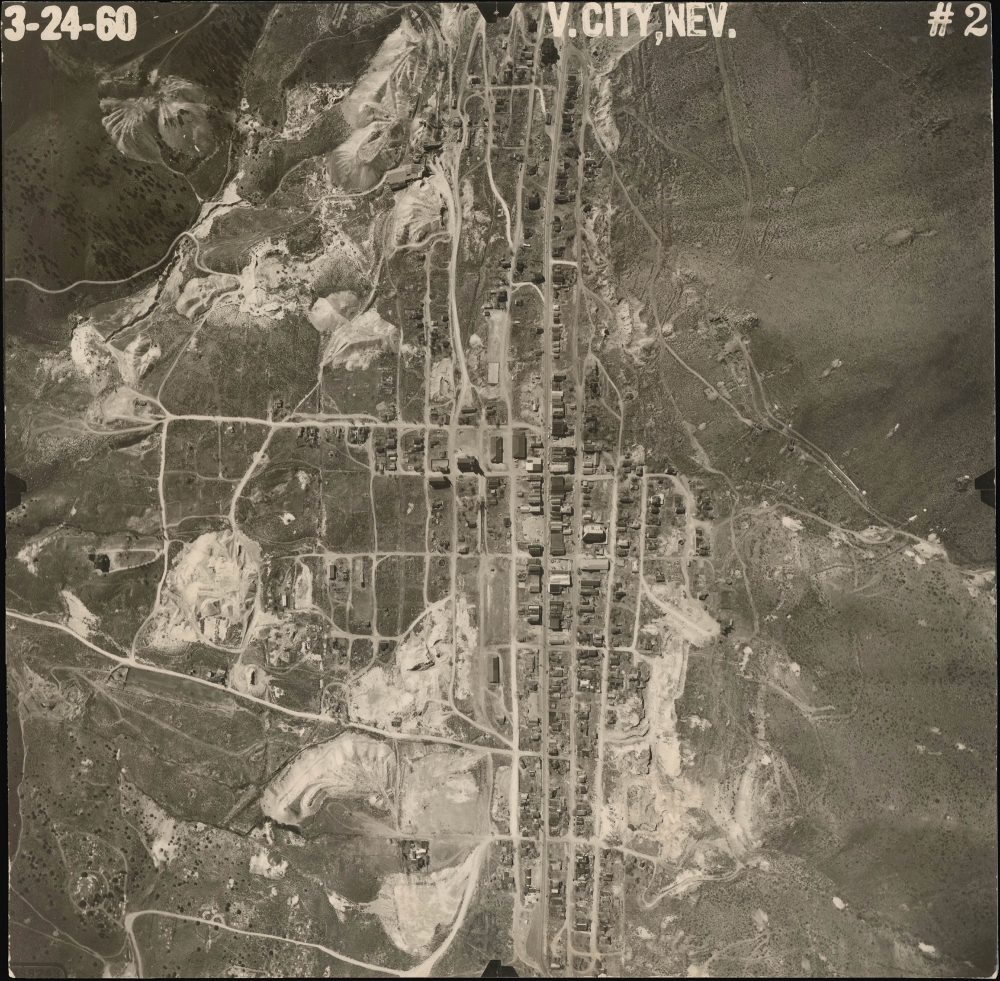1960 Aerial Photographs of Virginia City, Nevada
VirginiaCity-nvbureaumines-1960$300.00

Title
V. City, Nev. # 2 / V. City, Nev. # 3.
1960 (dated) 9 x 9 in (22.86 x 22.86 cm)
1960 (dated) 9 x 9 in (22.86 x 22.86 cm)
Description
An interesting pair of 1960 aerial photographs of Virginia City, Nevada, produced by the Nevada Bureau of Mines.
As the most significant discovery since the California Gold Rush of 1849, the Comstock discovery precipitated a major silver rush in 1859, leading to six great 'Bonanzas' and countless enormous fortunes. In total, between 1860 and 1880, nearly seven million tons of ore were extracted and milled in the Comstock district. During 1877, its peak year, over $14 million in gold and $21 million in silver were extracted. The Comstock Lode mines also led several technological advances, including square site timbering and the Washoe silver smelting process.
The discovery precipitated the construction of several boom towns, including Silver City and Virginia City, which appeared 'almost overnight' on the slopes of Mount Davidson after the discovery of the Comstock Lode. In 1862, Virginia City had a population of 4,000, and by the following year, it had reached 15,000, peaking at around 25,000 in 1873. Samuel Clemens worked for the local newspaper, the Territorial Enterprise, from 1862 until 1864. It was in Virginia City that he first used his famous pen name, Mark Twain.
Most histories suggest that silver in the region began to decline in 1874, but it was only the previous year that the largest discovery the 'Big Bonanza' occurred right below Virginia City! The mines remained active until the 1920s. Although Virginia City was undoubtedly a mining boomtown characterized by loose morals and violence, it was an unusually large and enduring boomtown boasting gas and sewer lines and luxurious hotels. After most of the city burned down in 1875, it was rebuilt with many brick buildings. For these reasons, though the population declined considerably in the early 20th century, Virginia City never became a ghost town as most of the other mining boomtowns of the late 19th century did.
A Closer Look
The photographs present a sequential view of the town, with the bottom-third of Photograph No. 3 overlapping with the top-third of Photograph No. 2. (The mountain at left is a useful reference point.) The main road through town, C. St. (NV SR 341), is readily visible, running north-south at the center. Along this route are many historic structures built in an Old West style, including an opera house, theaters, and churches, which have proven to be an attraction for tourists in recent years.Virginia City and the Comstock Lode
The Comstock Lode was the first major silver mine in the United States. Named after the fur trader and silver miner Henry Comstock (who did not himself profit from the discovery), the Comstock Lode was located under the eastern slope of Mount Davidson in the Virginia Range of modern-day Nevada. From about 1850, the area was known for gold, which Mormon emigrants discovered in nearby Gold Hill. The gold strike was impressive but difficult to mine because of an annoying blue-gray clay that clung to their picks and shovels. When the clay was finally assayed in 1858, it was discovered to be mostly silver, worth many thousands of dollars.As the most significant discovery since the California Gold Rush of 1849, the Comstock discovery precipitated a major silver rush in 1859, leading to six great 'Bonanzas' and countless enormous fortunes. In total, between 1860 and 1880, nearly seven million tons of ore were extracted and milled in the Comstock district. During 1877, its peak year, over $14 million in gold and $21 million in silver were extracted. The Comstock Lode mines also led several technological advances, including square site timbering and the Washoe silver smelting process.
The discovery precipitated the construction of several boom towns, including Silver City and Virginia City, which appeared 'almost overnight' on the slopes of Mount Davidson after the discovery of the Comstock Lode. In 1862, Virginia City had a population of 4,000, and by the following year, it had reached 15,000, peaking at around 25,000 in 1873. Samuel Clemens worked for the local newspaper, the Territorial Enterprise, from 1862 until 1864. It was in Virginia City that he first used his famous pen name, Mark Twain.
Most histories suggest that silver in the region began to decline in 1874, but it was only the previous year that the largest discovery the 'Big Bonanza' occurred right below Virginia City! The mines remained active until the 1920s. Although Virginia City was undoubtedly a mining boomtown characterized by loose morals and violence, it was an unusually large and enduring boomtown boasting gas and sewer lines and luxurious hotels. After most of the city burned down in 1875, it was rebuilt with many brick buildings. For these reasons, though the population declined considerably in the early 20th century, Virginia City never became a ghost town as most of the other mining boomtowns of the late 19th century did.
Publication History and Census
These photographs were part of a series of aerial photographs produced by the Nevada Bureau of Mines (now the Nevada Bureau of Mines and Geology) between the late 1930s and early 1990s. Though the University of Nevada, Reno, holds many of the aerial photographs from the series, the present photographs do not appear to be among them.Condition
Very good. Chipping and surface scuffing to photograph # 3. Light soiling to both photographs.






